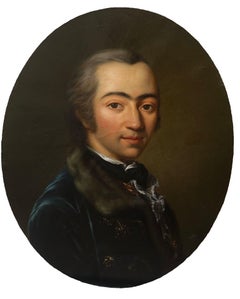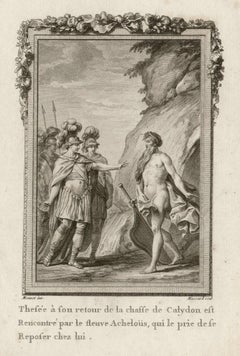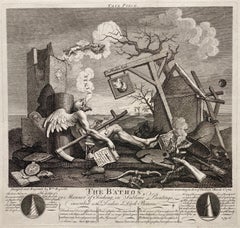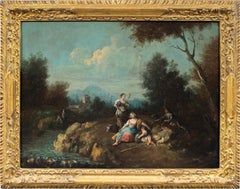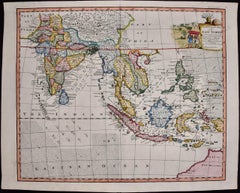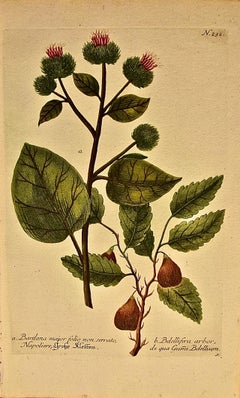Mid-18th Century Art
to
273
474
120
75
42
56
Overall Width
to
Overall Height
to
7,515
21,292
158,163
232,633
1,959
2,229
4,876
6,390
5,804
13,209
19,534
25,566
18,140
13,475
5,369
265
152
14
3
1
1
403
334
7
476
229
154
146
143
142
93
71
54
52
43
41
40
39
30
27
25
25
21
19
352
195
176
132
89
45
42
41
22
14
223
332
403
227
Period: Mid-18th Century
J.H. Tischbein the Elder, attrib. – Young Man in a Blue Velvet Coat
Located in Firenze, IT
J.H. Tischbein the Elder, attrib. – Young Man in a Blue Velvet Coat
J.H. Tischbein the Elder, attributed.
Oil on canvas, oval format, 63 × 50 cm.
Mid-18th century.
The painting de...
Category
Rococo Mid-18th Century Art
Materials
Canvas, Oil
Theseus and Achelous, Ovid's Metamorphoses, French Classical engraving, 1768
Located in Melbourne, Victoria
Copper-line engraving by Massard after Charles Monnet (1732-1808).
Theseus returns from the Calydonian hunt and is met by the river god Achelous.
From...
Category
Naturalistic Mid-18th Century Art
Materials
Engraving
BATHOS / Tail PIece
Located in Santa Monica, CA
WILLIAM HOGRATH (1767- 1764)
THE BATHOS / Tail Piece 1764 (Paulson 1989: 216 I/I Paulson 1965/70: 216 I/I)
Engraving Plate 12 7/8 x 13 3/8, sheet 17 ¾ x 18 ¾ Designed & Engrav’d by Wm Hogarth at left and Published according to Act of Parliam’t March 3, 1764 at right. Good condition on thick laid paper Small bit of tape on the left & right sheet edges small stan lower sheet edge all on recto.
This Hogarth’s last print is fascinating as it is prophacy about death.
Various institutions have interesting commentaries - to wit:
Chicago Art Institute: Hogarth created The Bathos toward the end of his life. It is considered one of the bleakest artworks of the 18th century because it depicts the Apocalypse without an afterlife. The Angel of Death even collapses in exhaustion after having destroyed the world. In his hand is an execution decree and around him lies a mass of broken objects.
Princeton: Hogarth’s last print, The Bathos,….. is filled with all manner of images denoting the end of life as we know it. Entry no. 216 in Ronald Paulson’s catalogue raisonne Hogarth’s Graphic Works, 3rd revised edition says “This print is the culmination of such pessimistic images . . . . [taking] his general composition, the configuration of objects, and some of the particular items, from Dürer’s engraving, Melancholia; but he also recalls Salvator Rosa’s Democritus in Meditation (which derives from Dürer’s print) with a scroll at the bottom of the etching: ‘Democritus the mocker of all things, confounded by the ending of All Things’ (Antal, p.168).”
Newfields (Indianapolis Museum of Art): Hogarth intended this engraving to serve as the tailpiece to bound volumes of his collected engravings and, appropriately, it proved to be his last engraving. Father Time has died and his last will and testament has been witnessed by the three Fates. He is surrounded by a landscape of death, decay, and ruin. Hogarth aimed this print at dealers in “dark” Old Masters paintings who promoted the idea that ruins evoked sublime feelings in viewers—a sentiment, Hogarth wrote, that was reducing the world to ruin.
British Caricature...
Category
Old Masters Mid-18th Century Art
Materials
Woodcut
Giuseppe Zais (Venetian master) - 18th century landscape painting - Figures
By Giuseppe Zais (Canale d'Agordo, Belluno 1709 - Treviso 1781)
Located in Varmo, IT
Giuseppe Zais (Forno di Canale 1709 - Treviso 1784) - Landscape with shepherds and spinner.
48 x 63.5 cm without frame, 59 x 74.5 cm with frame.
Oil on canvas, in a carved and gild...
Category
Rococo Mid-18th Century Art
Materials
Canvas, Oil
Map of the East Indies: An Original 18th Century Hand-colored Map by E. Bowen
Located in Alamo, CA
This is an original 18th century hand-colored map entitled "An Accurate Map of the East Indies Exhibiting the Course of the European Trade both on the Continent and Islands" by Emanu...
Category
Old Masters Mid-18th Century Art
Materials
Engraving
$1,020 Sale Price
20% Off
Flowering Bardana Daisy: 18th Century Hand-colored Weinmann Botanical Engraving
Located in Alamo, CA
This hand-colored botanical mezzotint and line engraving by Johann Wilhelm Weinmann (1683-1741) is entitled "A. Bardana Major Folio Non Serrato, Napoliere, B. Bdellifera Arbor, de Qu...
Category
Naturalistic Mid-18th Century Art
Materials
Engraving, Mezzotint
Still Life Garland of Flowers - Flemish 18thC art Old Master floral oil painting
By Pieter Casteels III
Located in Hagley, England
This superb 18th century Old Master floral still life oil painting is attributed to Flemish artist Pieter Casteels III. Painted circa 1730 it is a garland or swag of flowers, somethi...
Category
Old Masters Mid-18th Century Art
Materials
Oil
$19,593 Sale Price
20% Off
Battle Scene - Original Etching Hand Watercolored After Antonio Simonini - 1760
By Luigi Guidotti
Located in Roma, IT
Scena di Battaglia (Battle Scene) is a wonderful hand-watered etching, made in 1760 by Luigi Guidotti ( Bologna, 1751 -1800 c.a), after Francesco Antonio Simonini.
On lower margin u...
Category
Old Masters Mid-18th Century Art
Materials
Watercolor, Etching
Cultivated Pea Plants: An 18th C. Hand-colored Botanical Engraving by Weinmann
Located in Alamo, CA
This hand-colored botanical mezzotint and line engraving by Johann Wilhelm Weinmann (1683-1741) is entitled "a. Pisum Minus sine Putamine, b. Pisa Indicum". It is plate 819 in Weinma...
Category
Naturalistic Mid-18th Century Art
Materials
Engraving, Mezzotint
Al Dolo - Etching by Giovanni Antonio Canal - 1735/44
By Giovanni Antonio Canal (Canaletto)
Located in Roma, IT
Al Dolo is an original Artwork realized by Giovanni Antonio Canal, commonly known as Canaletto (Venice, 1697 - 1768).
Original Etching on Laid paper...
Category
Modern Mid-18th Century Art
Materials
Etching
From Renaissance Venice to Barocco Naples, a drawing by Francesco La Marra
Located in PARIS, FR
This vigorous drawing presents a brilliant synthesis between the Venetian tradition of Titian, of which it is a distant echo, and the Neapolitan Baroque of Solimena, which strongly i...
Category
Old Masters Mid-18th Century Art
Materials
Paper, Ink, Felt Pen
Flowering Apple Plant: 18th Century Hand-colored Botanical Engraving by Weinmann
Located in Alamo, CA
This striking hand-colored botanical mezzotint and line engraving is entitled Malus domestica, Pomier, Apfelbaunt (Apple)". It is plate 704 in Johann Weinmann's monumental publicatio...
Category
Naturalistic Mid-18th Century Art
Materials
Engraving, Mezzotint
Scultura Barocca di Angelo in Terracotta Policroma Italia XVIII secolo
Located in Pistoia, IT
Scultura in terracotta policroma raffigurante un angelo alato, Italia, XVIII secolo.
L'angelo è plasmato con grande maestria, dalle forme rotonde tipiche del Barocco italiano. Gli ...
Category
Baroque Mid-18th Century Art
Materials
Terracotta
Skeleton after Titian - Etching by Jean François Poletnich - 1755
Located in Roma, IT
Skeleton after Titian is an etching realized by Jean Francois Poletnich in 1755.
Signed in the plate.
Good conditions with foxing.
The artwork is depicted through confident stroke...
Category
Modern Mid-18th Century Art
Materials
Etching
Escuela española (XVIII) - Virgen Dolorosa - Óleo sobre tela
Located in Sant Celoni, ES
Como pueden apreciar, la obra no va firmada, es de autor anónimo
Se presenta enmarcada la obra (el marco presenta algunos signos de uso)
El estado de la obra se puede ver, presenta...
Category
Baroque Mid-18th Century Art
Materials
Oil
$760 Sale Price
20% Off
Character vs. Charicature
Located in Wilton Manors, FL
William Hogarth (1697-1764).
Character vs. Charicature, 1743.
Engraving on laid paper, plate measuring 8.25 x 9.25 inches. Framed measurement: 16.25 x 20.25 inches.
Characters and...
Category
Realist Mid-18th Century Art
Materials
Engraving
Ancient Roman Temple Architecture: An 18th Century Framed Etching by Piranesi
Located in Alamo, CA
This is an 18th century etching by Giovanni Battista Piranesi entitled "Veduta del Tempio detto della Tosse su la Via Tiburtina, un miglio vicino a Tivoli" (View of the so-called Tem...
Category
Old Masters Mid-18th Century Art
Materials
Etching
Flowering Sweet William Plant: 18th C. Hand-colored Weinmann Botanical Engraving
Located in Alamo, CA
This hand-colored botanical mezzotint and line engraving by Johann Wilhelm Weinmann (1683-1741) is entitled "a. Caryophyllus Arborescens, b. Caryophyllus Barbatus". It is plate 327 i...
Category
Naturalistic Mid-18th Century Art
Materials
Engraving, Mezzotint
Landscape - Etching by Pierre-François Laurent - 1755
Located in Roma, IT
Landscape is an etching realized by Pierre-François Laurent in 1755.
Good condition.
Signed on Plate.
The artwork is depicted through confident strokes.
The etching was realized ...
Category
Modern Mid-18th Century Art
Materials
Etching
$142 Sale Price
40% Off
Oval 18th century Portrait of a Young girl, oil on copper
By (Follower of) Sir Godfrey Kneller
Located in Woodbury, CT
This exquisite 18th-century portrait depicts a young girl, delicately rendered in the style of Sir Godfrey Kneller, one of the most celebrated portrait painters of the Baroque period...
Category
Old Masters Mid-18th Century Art
Materials
Copper
Flowering Medlar Tree: An 18th C. Hand-colored Botanical Engraving by Weinmann
Located in Alamo, CA
This hand-colored botanical mezzotint and line engraving by Johann Wilhelm Weinmann (1683-1741) is entitled "A. Mespilus Aronia Azarolie B. Mespilus Vulgaris Neflier". It is plate 7...
Category
Naturalistic Mid-18th Century Art
Materials
Engraving, Mezzotint
Preparations for the fireworks display held in Piazza Navona in 1729
Located in Paris, Île-de-France
VERY IMPORTANT DRAWING BY
JACQUES DUMONT called « LE ROMAIN"
(Paris 1701-1781)
Preparations for the fireworks display held in Piazza Navona in Rome on November 30,
1729, for the bi...
Category
French School Mid-18th Century Art
Materials
Chalk, Ink, Pen
Mary, Mother of God, Italian Master circa 1780, Carved Wood, slightly damaged
Located in Eltville am Rhein, DE
Madonna, Mary Mother of God
Italy, circa 1780
Linden wood, painted/gilded
Dimensions: 80 x 32 x 24 cm
Painting/gilding damaged in places
Authenticity guaranteed in writing
Category
Baroque Mid-18th Century Art
Materials
Wood
Study of a Putto with Attributes of Painting
Located in New York, NY
Circle of François Boucher (1703–1770)
Study of a Putto with Attributes of Painting
Chalk on paper
Not signed
An elegant Rococo drawing depicting a winged putto with a painter’s pal...
Category
Rococo Mid-18th Century Art
Materials
Animal Skin, Paper, Chalk
Fete Champetre - Garden Party - French 18thC figurative landscape oil painting
Located in Hagley, England
This charming 18th century French Old Master oil painting is attributed to circle of Joseph Frans Nollekens. Painted circa 1740 it is described as a fete champetre - a form of entertainment in the 18th century, taking the form of a garden party. They were often elegant affairs and became very popular in 18th French paintings. Antoine Watteau invented the genre, from around 1710 and they were also included as a category in the French Academy. In this painting, several well dressed figures are sat in the foreground by a fountain and statue, being entertained by a musician. Beyond, a wide avenue of trees leads towards a very grand country house with countryside beyond. There is superb detail in the figures and their colourful clothing. The brushwork in the trees and sky is also superb. This is a charming example of an 18th century fete champetre and of a French Old Master oil painting.
Provenance. Gloucester estate.
Condition. Oil on canvas. Image size 49 inches by 30 inches and in good condition.
Frame. Housed in a fine gilt frame, 56 inches by 37 inches and in good condition.
Josef Frans Nollekens or Joseph Frans Nollekens (1702–1748)[2] was a Flemish painter who was principally active in England where he is often referred to as "Old Nollekens" to distinguish him from his famous son, the sculptor Joseph Nollekens. He painted conversation pieces, galant companies and fêtes champêtres in the style of Watteau, genre scenes as well as portraits. He was also active as a picture restorer.
A fête champêtre was a form of entertainment in the 18th century, taking the form of a garden party. This form of entertainment was particularly practised by the French court, where in the Gardens of Versailles and elsewhere areas of the park were landscaped with follies, pavilions, and temples to accommodate such festivities. The term is a French expression, very literally translating as "party in the fields", meaning a "pastoral festival" or "country feast" and in theory was a simple form of entertainment, perhaps little more than a picnic or informal open air dancing. In practice, especially in the 18th century, the simplicity of the event was often contrived. A fête champêtre was often a very elegant form of entertainment involving on occasions whole orchestras hidden in trees, with guests sometimes in fancy dress. Such events became a popular subject in French 18th-century painting, representing a glamourized aristocratic form of pastoral, with "scenes of well dressed dalliance in a park setting". Antoine Watteau invented the genre, from around 1710, and is its best exponent, imitated by others such as Nicolas Lancret and Jean-Baptiste Pater...
Category
Old Masters Mid-18th Century Art
Materials
Oil
$17,416 Sale Price
20% Off
Flowering Burning Bush: 18th Century Hand-colored Weinmann Botanical Engraving
Located in Alamo, CA
This is an original antique colored botanical mezzotint and line engraving of flowering Gas Plants or Burning Bush and Fraxinella, which is finished with hand-coloring. It is entitle...
Category
Naturalistic Mid-18th Century Art
Materials
Engraving, Mezzotint
GRAN CONCHA PINTADA CON MARCO DE PLATA - IMPORTANTE PIEZA LITURGICA
Located in Sant Celoni, ES
Importante conjunto litúrgico de concha de nácar pintada, con escena religiosa.
Va con marco de plata trabajada y flores, es un trabajo de orfebrería muy detallado y de calidad.
El...
Category
Mid-18th Century Art
Materials
Oil
Ancient Roman Marble Vase: 18th C. Piranesi Etching Vaso Cinerario di Gran Mole
Located in Alamo, CA
"Vaso Cinerario di Gran Mole. Le Teste dei Giovenchi mostrano di reggere it pesante Festone composto di Frutti Fiori Grans ed use. Il tuto Necefsario all Vita Umana. Il Restante degl...
Category
Old Masters Mid-18th Century Art
Materials
Etching
Woodpeckers "Le Petit Pic" An 18th Century Hand-colored Engraving by Martinet
Located in Alamo, CA
This is a hand-colored engraving of male and female woodpeckers entitled "1. Le Petit Pie varie, 2. Sa Femelle" by Francois Nicolas Martinet, plate 598 from 'Histoire Naturelle des O...
Category
Naturalistic Mid-18th Century Art
Materials
Engraving
Piranesi Etching of Hadrian's Ancient Roman Aqueduct and Baths, "Aquae Virginis"
Located in Alamo, CA
This is a framed Giovanni Battista Piranesi (1720-1778) etching entitled "Orthographia utriusque lateris arcuum ductus Aquae Virginis a specu principe ad Hadriani thermas, effossorum...
Category
Old Masters Mid-18th Century Art
Materials
Etching
Colonel Mellish's Spaniels, Mother & Puppies, 18th Century
Located in Blackwater, GB
Colonel Mellish's Spaniels, Mother & Puppies, 18th Century
attributed to HENRY BERNARD CHALON (1770-1849)
Large 18th Century portrait of Colonel Mellish's hunting spaniels, mother ...
Category
Mid-18th Century Art
Materials
Oil, Panel
$3,238 Sale Price
30% Off
The Happy Consultation, or Modern Match
Located in Santa Monica, CA
EIGHTEENTH CENTURY BRITISH CARICATURE
THE HAPPY CONSULTATION, or MODERN MATCH, 1769 (DG 4335)
...
Category
Old Masters Mid-18th Century Art
Materials
Engraving
$325 Sale Price
56% Off
Europe: An Original 18th Century Hand-colored Map by E. Bowen
Located in Alamo, CA
This is an original 18th century hand-colored map entitled "A New & Accurate Map of Europe Drawn from the Best Authorities Assisted by the Most Improved Modern Charts and Maps." by E...
Category
Old Masters Mid-18th Century Art
Materials
Engraving
$940 Sale Price
20% Off
Marquis de Marigny: An 18th C. Wille Engraved Portrait after a Tocque Painting
By Louis Tocqué
Located in Alamo, CA
This is a mid 18th century engraved portrait of Abel François Poisson de Vandières, Marquis de Marigny by Jean Georges Wille after a painting by Louis Tocque...
Category
Mid-18th Century Art
Materials
Engraving
$2,060 Sale Price
20% Off
Gaspare Diziani (Venetian Rococò) - 18th century figure painting - Virgin Child
Located in Varmo, IT
Gaspare Diziani (Belluno 1689 – Venice 1767) - Madonna and Child.
74 x 58 cm unframed, 88.5 x 69.5 cm with frame.
Ancient oil painting on canvas, in a carved and gilded wooden fram...
Category
Rococo Mid-18th Century Art
Materials
Canvas, Oil
Portrait of a Lady
By Francesco Guardi
Located in Paris, Île-de-France
Francesco GUARDI (1712-1793)
Portrait of a Lady
Oil on copper
5 1/8 x 4 3/8 in
13 x 11 cm
Unsigned
Provenance
Private collection, France
We are pleased to present an exceptional...
Category
Old Masters Mid-18th Century Art
Materials
Copper
Baroque wax religious figurative bas-relief from the 18th century
Located in Florence, IT
Polychrome wax relief on chalkboard, 20 x 15 cm; with ebony and tortoiseshell frame, 28 x 23 cm
The scene depicts Mary Magdalene in the center, seated on a rock with a handkerchief i...
Category
Baroque Mid-18th Century Art
Materials
Slate
Genip Tree & Fruit: An 18th C. Hand-colored Botanical Engraving by J. Weinmann
Located in Alamo, CA
This hand-colored botanical mezzotint and line engraving by Johann Wilhelm Weinmann (1683-1741) is entitled "A. Geniculata Wieder Kraief, B. Genipa seu Ganipaba". It is plate 531 in...
Category
Naturalistic Mid-18th Century Art
Materials
Engraving, Mezzotint
Sir Francis Drake: 18th C. Portrait of 16th C. Navigator, Privateer, Politician
Located in Alamo, CA
This an 18th century copper plate engraved portrait of Sir Francis Drake by Jacobus Houbraken, after a painting by Sir Godfrey Kneller, from "The Hea...
Category
Mid-18th Century Art
Materials
Engraving
Rococò Italian painter - 18th century figure painting - The Street Show
Located in Varmo, IT
Italian painter (18th century) - Street theater.
74.5 x 62.5 cm without frame, 86 x 73.5 cm with frame.
Antique oil painting on canvas, in a gilded wooden frame (not signed).
Cond...
Category
Rococo Mid-18th Century Art
Materials
Canvas, Oil
$2,969 Sale Price
47% Off
Flowering Spurge: 18th Century Hand-colored Botanical Engraving by J. Weinmann
Located in Alamo, CA
This hand-colored botanical mezzotint and line engraving by Johann Wilhelm Weinmann (1683-1741) is entitled "A. Esula seu Tithyinalus Africanus SpinosusCera Effigie, B. Esula seu Ti...
Category
Naturalistic Mid-18th Century Art
Materials
Engraving, Mezzotint
Anatomy Studies - Etching by Nicholas Cochin - 1755
Located in Roma, IT
Anatomy Studies is an etching realized by Nicholas Cochin in 1755.
Good conditions with foxing and folding.
The artwork is depicted through confident strokes.
The etching was realized for the anatomy study “JOMBERT, Charles-Antoine (1712-1784) - Méthode pour apprendre le dessein, ou l'on donne les regles générales de ce grand Art.. enrichie de cent planches representant differentes parties du Corps Humain.. et quelques etudes d`Animaux & de Paysage. Paris: C.A. Jombert, 1755”
The plates of this important study were mainly dedicated to anatomical studies, physiognomy and proportions, many taken from works by famous artists such as Raphael, Guido Reni and Titian, as well as classical works including the Farnese Hercules and the Medici Venus.
Category
Modern Mid-18th Century Art
Materials
Etching
$199 Sale Price
40% Off
Castle and Town of Tanlay, French architecture, mid 17th century engraving
Located in Melbourne, Victoria
'Prosp du Chasteau et Bourg de Tanlay'
Copper-line engraving by Matthaeus Merian.
From 'Topographia Galliae', a fine series of engravings of 17th-century French landscapes, garden...
Category
Rococo Mid-18th Century Art
Materials
Engraving
The So-Called Tempio della Tosse, Near Tivoli. Interior Upright
Located in Fairlawn, OH
The So-Called Tempio della Tosse, Near Tivoli. Interior Upright (Veduta interna del Tempio della Tosse)
"Temple of the Cough"
Etching, 1764
Signed in the plate
From: Vedute di Roma...
Category
Old Masters Mid-18th Century Art
Materials
Etching
Garden's Flowers - Ink and Watercolor Drawing by Jan Pieter Verdussen - 1750s
Located in Roma, IT
Garden's Flowers is a beautiful artwork realized by Jan Peter Verdussen.
In good condition.
Not signed.
Passepartout included ( 48.8 x 33.8 cm).
The artwork represents a Garden's...
Category
Old Masters Mid-18th Century Art
Materials
Paper, Ink, Watercolor
Red Geranium: An 18th Century Hand-colored Botanical Engraving by J. Weinmann
Located in Alamo, CA
This is an original antique colored botanical mezzotint and line engraving of flowering Red Geraniums which is finished with hand-coloring. It is entitled "Geranium Anemones folio Af...
Category
Naturalistic Mid-18th Century Art
Materials
Engraving, Mezzotint
Landscape - Pencil and Watercolor by Jan Pieter Verdussen - 1750
Located in Roma, IT
Landscape is a beautiful drawing in watercolor and pencil on ivory-colored paper realized by Jan Peter Verdussen.
In good condition; only a smallspots at the edges of the drawing an...
Category
Old Masters Mid-18th Century Art
Materials
Paper, Ink, Watercolor
Turtledove of Senegal: An 18th Century Hand-colored Bird Engraving by Martinet
Located in Alamo, CA
This is a hand-colored engraving of a turtledove entitled "Tourterelle a Collier, du Senegal (Turtledove of Senegal)" by Francois Nicolas Martinet, plate 161 from 'Histoire Naturelle...
Category
Naturalistic Mid-18th Century Art
Materials
Engraving
Appearance - Etching by C.N. Cochin the Elder - 1750s
Located in Roma, IT
Appearance is a black and white etching on cream-colored paper, realized by Charles-Nicolas Cochin the Elder (1688-1754) in 1750s.
Good condition.
Category
Old Masters Mid-18th Century Art
Materials
Etching
Thomas Hudson Style 18th Century English Portrait
Located in Roma, IT
Important English school painting in the style of the great artist Thomas Hudson (Devonshire 1701 - Twickenham 1779)
It depicts the portrait of Harry Gray (1715-1768), 4th Earl of St...
Category
Old Masters Mid-18th Century Art
Materials
Canvas, Oil
Peacock Butterfly, Moth & Botanical: An 18th C. Hand-colored M. Harris Engraving
By Moses Harris
Located in Alamo, CA
This is a rare, original first edition hand-colored engraving of Peacock Butterflies and Water Betony Moths depicted in their natural botanical environment, which is plate 8 from Mos...
Category
Mid-18th Century Art
Materials
Engraving
Early Naturalistic Wildlife Animal Rendering of a Possible Capuchin Monkey
Located in Houston, TX
Early naturalistic wildlife rendering by the English artist Peter Paillou. The work features a delicately rendered depiction of a possible capuchin monke...
Category
Naturalistic Mid-18th Century Art
Materials
Gouache
La Bataille - The Battle - Drawing by J. P. Verdussen - 1740s
Located in Roma, IT
China ink and watercolor on paper.
Conditions: Two cuts on the centre of the paper. Three holes on centre-right, botton-left and top-left of the paper.
Worn on the top left of the ...
Category
Old Masters Mid-18th Century Art
Materials
Ink, Watercolor
Flowering Narcissus Lily: 18th Century Hand-colored Weinmann Botanical Engraving
Located in Alamo, CA
This is an original antique colored botanical mezzotint and line engraving of a flowering Red Narcissus Lily plant, which is finished with hand-coloring. It is entitled "Narcissus In...
Category
Naturalistic Mid-18th Century Art
Materials
Engraving, Mezzotint
Framed eighteenth century botanical engraving in a decalcomania frame.
Located in Richmond, GB
From a wonderful selection of hand-coloured mezzotint engravings from: "Phytanthoza Iconographia", c1739, presented in a hand- made parcel-gilt, ebonised and decalcomania frame. So...
Category
Mid-18th Century Art
Materials
Handmade Paper, Engraving, Mezzotint
Landscape with Ruins and Figures - British 18thC Old Master art oil painting
Located in Hagley, England
This superb British 18th century Old Master oil painting is attributed to circle of noted landscape artist Richard Wilson. Painted circa 1750 it is a stunning light, bright and airy expansive panoramic landscape. There is a river in the foreground and mountains in the background. On the left of the river stands some ruins and on the right, figures are resting under the trees. The palette of blues, greens and very varied and rich with some lovely pinky brown tones for the land on the right. The brushwork is also delicate but confidently executed. A superb example of a British Old Master landscape oil painting, finished off in a carved and gilt wood English Rococo frame with name plate.
Provenance. The Asbjorn Lunde Foundation, Inc. Throughout his long life, Mr. Lunde supported more than forty museums in his native New York, across the United States, and in Europe with loans, gifts, and funding. Mr. Lunde was a proud New Yorker with roots in Norway. He was keenly interested in nineteenth-century Scandinavian and Swiss landscape painting, Old Master painting, and Asian decorative arts.
According to an old label to the reverse, the present painting was once owned by James Northcote (1746-1831) who gave it to William Hillman on 25th May 183(0?)
Property of the Bacot family.
Christies stamps verso.
Watson Gallery London. Remains of label verso.
Condition. Oil on canvas, 26 inches by 18 inches and in good condition.
Frame. Housed In a carved and gilt wood English Rococo frame bearing Richard Wilson name plate, 33 inches by 25 inches and in good condition.
Richard Wilson RA...
Category
Old Masters Mid-18th Century Art
Materials
Oil
$23,947 Sale Price
20% Off
Curlew Bird and Charleston, SC: Original 1st Ed. Audubon Hand-colored Lithograph
Located in Alamo, CA
This is an original rare and extremely collectible first edition John James Audubon hand colored lithograph entitled "Long-billed Curlew", No. 71, Plate 355, from Audubon's "Birds of America. It was lithographed, printed and colored by J. T. Bowen and published in Philadelphia between 1840-1844. It depicts a male and a female Long-billed Curlew standing on a grassy mound with water and the skyline of the city of Charleston...
Category
Naturalistic Mid-18th Century Art
Materials
Lithograph
Cacti, Rio Grande, Black and White, USA 1960s, 16, 4 x 23, 1 cm
By Erich Andres
Located in Cologne, DE
Silver Gelatine Print by Erich Andres, ca 1950.
Andres was born 1905 in Germany and passed away 1992. He started his career as a photographer in 1920. He was one of the first photogr...
Category
Modern Mid-18th Century Art
Materials
Silver Gelatin, Black and White
Deutzia Flowers: The Wife of Kasamori - Original Woodblock Print
Located in Soquel, CA
Deutzia Flowers: The Wife of Kasamori - Original Woodblock Print
Deutzia Flowers: The Wife of Kasamori, from the Series "Beauties of the Floating World Associated with Flowers" by S...
Category
Edo Mid-18th Century Art
Materials
Woodcut, Ink, Rice Paper
$720 Sale Price
20% Off
18th Century Oil on Panel Italian Mythological Painting, 1760
Located in Vicoforte, IT
A rare 18th-century Italian painting. Oil on panel artwork depicting a captivating mythological subject, Mercury delivers the infant Bacchus to the Nymphs of Mount Nysa. According to...
Category
Mid-18th Century Art
Materials
Wood, Oil
Recently Viewed
View AllMore Ways To Browse
Maggie Siner
Maplethorpe Calla
Marble Woman Head
Marcel Leprin
Mark Stock
Martin Hardie
Mauritz Lindstrom
Maximillien Luce
Michael Budden Central Park
Midcentury Matador Paintings
Mike Wright
Miracle On Ice
Mississippi River Painting
Monarch Of The Glen Painting
Moroccan Paintings Essaouira
Morpho Butterfly Art
Mount Tamalpais
Murray Dessner
